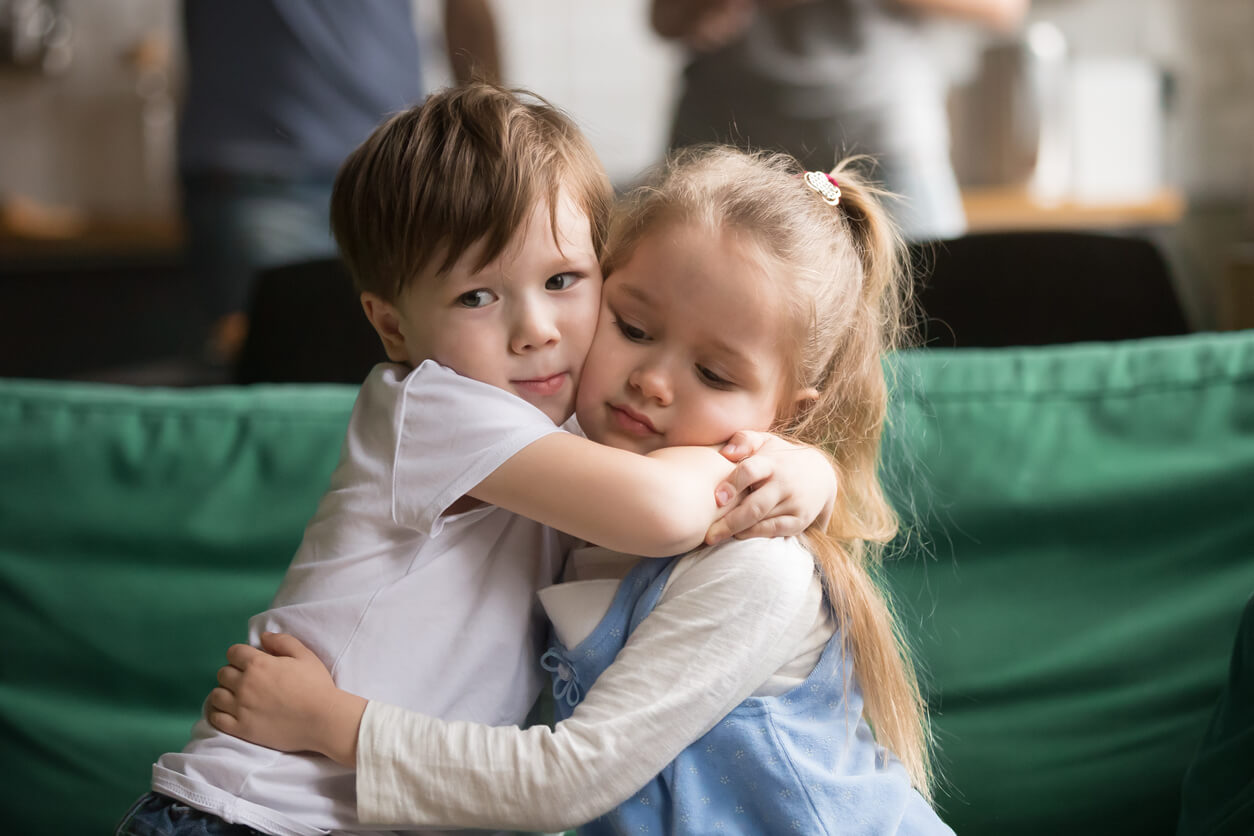The 5 Apology Languages: How to Work on Them with Your Children


Written and verified by the psychologist Elena Sanz Martín
Emotional education is one of the educational aspects to which we’re giving more importance in recent times. Parents and teachers do their best to instill in children values, regulation strategies, and social skills that are useful in their daily lives. If you’re immersed in this task, we want to talk to you about the 5 apology languages and why it’s important to work on them with your children.
We all make mistakes, and so do children. This is natural and acceptable; however, it’s important to transmit to them enough humility to recognize their failures and try to improve. However, not everyone has the same idea of what an apology is. Therefore, sometimes, the goodwill of the other person isn’t enough for us to feel that the damage has been compensated for.
What are the 5 apology languages?
Perhaps you’ve already heard about Gary Chapman’s five love languages. With this proposal, the author affirms that there are five different ways to express affection and that each person feels a predilection for one or the other. Along the same lines, this American author has described five ways to proceed when we need to apologize to others and mend the relationship.
It’s precisely the difference in apology languages that causes great misunderstandings and undermines bonds. Perhaps, the apology the other person offers us doesn’t sound sincere, feels incomplete, or isn’t enough to restore trust. And this is because they speak with different codes than we do.
If we teach children about this, we show them that each person needs something different to forgive and that it’s important to take this into account in order to give it to them. Also, we help them understand what they need in order to grant forgiveness so that they can set their limits and express themselves clearly and assertively in the face of disagreements. But what are these 5 apology languages? We’ll show them to you below.

1. Express regret
This speaks to the emotional aspect of the apology; that is, expressing how you feel about what you’ve done. It can be embarrassed, guilty, sad, or overwhelmed, among others. The idea is to emphasize that you feel bad about your mistake and that it makes you feel bad to have made it. It also validates another person’s emotions by expressing that you understand that your behavior has caused them pain, sadness, or anger.
2. Accept responsibility
In this case, it’s about recognizing, without buts or excuses, that you’ve made a mistake or have done something wrong. We must accept that we’re responsible, without trying to blame others or the circumstances or looking for extenuating circumstances. For example, saying “I’m sorry I broke your toy, but you made me angry” isn’t a good apology in this context. For, any “but” cancels that recognition of responsibility.
3. Restore the damage done
For those who have this apology language, it’s very important to know that the other person still loves them even after what happened. Therefore, they value signs of interest and the effort to repair the damage caused. They appreciate it when the other person shows a willingness to make amends and asks what they can do to fix the situation.
4. Expressing a willingness to change
Many people appreciate above all else that the person who has wronged them is willing to change so that they won’t make the same mistake again. This indicates that they know they’ve done something wrong and don’t want to do it again. Therefore, they need the other person to verbalize that they’ll work on improving, even if it takes some time.

5. Ask for forgiveness
Finally, there are those who need the other person to ask for forgiveness in a direct and humble way. That is, to give the offended party the possibility to decide whether or not to accept your apology once they’ve expressed how much they wish to be forgiven. For some people, this is difficult to do, because it puts a strain on their personal pride and makes them feel too vulnerable or exposed to the other’s response. However, it may be necessary in some cases.
Working on the 5 apology languages with children
It can be difficult for young children to understand the difference between these 5 forms of apology. Therefore, it’s very positive to use games and practical activities to bring them closer. For example, you can proceed in this way:
- Explain that each person needs to be apologized to in a different way and tell what each of the 5 languages consists of.
- Help the child identify which one is their own and discuss which one each family member prefers.
- Do role-playing exercises, in which the different forms of forgiveness are acted out or staged. For example, “how would you apologize to someone who has a language of expressing regret?”. This will help them practice and have the necessary phrases and actions to handle the different languages of forgiveness.
- Rely on stories or movies. If you watch a scene in which the main characters make a mistake and apologize, you can use this as an opportunity to discuss what kind of language they’ve used.
- Create flashcards with phrases that represent the different languages. When you pull them out, ask the child to guess which one it is. For example, a card that says “what I did is wrong, I have no excuse” would represent the language of taking responsibility.
Enjoying healthy relationships
With these activities that can serve as a game, children become familiar with the different ways of apologizing and will become increasingly skilled at handling them. The truth is that studies have found that children naturally tend to apologize and use different strategies to do so.
In particular, the 5 apology languages will help them resolve conflicts with their siblings and peers and avoid misunderstandings. If they’re able to own their mistakes and understand what other needs to feel better, they’ll enjoy healthier and more lasting relationships.
Emotional education is one of the educational aspects to which we’re giving more importance in recent times. Parents and teachers do their best to instill in children values, regulation strategies, and social skills that are useful in their daily lives. If you’re immersed in this task, we want to talk to you about the 5 apology languages and why it’s important to work on them with your children.
We all make mistakes, and so do children. This is natural and acceptable; however, it’s important to transmit to them enough humility to recognize their failures and try to improve. However, not everyone has the same idea of what an apology is. Therefore, sometimes, the goodwill of the other person isn’t enough for us to feel that the damage has been compensated for.
What are the 5 apology languages?
Perhaps you’ve already heard about Gary Chapman’s five love languages. With this proposal, the author affirms that there are five different ways to express affection and that each person feels a predilection for one or the other. Along the same lines, this American author has described five ways to proceed when we need to apologize to others and mend the relationship.
It’s precisely the difference in apology languages that causes great misunderstandings and undermines bonds. Perhaps, the apology the other person offers us doesn’t sound sincere, feels incomplete, or isn’t enough to restore trust. And this is because they speak with different codes than we do.
If we teach children about this, we show them that each person needs something different to forgive and that it’s important to take this into account in order to give it to them. Also, we help them understand what they need in order to grant forgiveness so that they can set their limits and express themselves clearly and assertively in the face of disagreements. But what are these 5 apology languages? We’ll show them to you below.

1. Express regret
This speaks to the emotional aspect of the apology; that is, expressing how you feel about what you’ve done. It can be embarrassed, guilty, sad, or overwhelmed, among others. The idea is to emphasize that you feel bad about your mistake and that it makes you feel bad to have made it. It also validates another person’s emotions by expressing that you understand that your behavior has caused them pain, sadness, or anger.
2. Accept responsibility
In this case, it’s about recognizing, without buts or excuses, that you’ve made a mistake or have done something wrong. We must accept that we’re responsible, without trying to blame others or the circumstances or looking for extenuating circumstances. For example, saying “I’m sorry I broke your toy, but you made me angry” isn’t a good apology in this context. For, any “but” cancels that recognition of responsibility.
3. Restore the damage done
For those who have this apology language, it’s very important to know that the other person still loves them even after what happened. Therefore, they value signs of interest and the effort to repair the damage caused. They appreciate it when the other person shows a willingness to make amends and asks what they can do to fix the situation.
4. Expressing a willingness to change
Many people appreciate above all else that the person who has wronged them is willing to change so that they won’t make the same mistake again. This indicates that they know they’ve done something wrong and don’t want to do it again. Therefore, they need the other person to verbalize that they’ll work on improving, even if it takes some time.

5. Ask for forgiveness
Finally, there are those who need the other person to ask for forgiveness in a direct and humble way. That is, to give the offended party the possibility to decide whether or not to accept your apology once they’ve expressed how much they wish to be forgiven. For some people, this is difficult to do, because it puts a strain on their personal pride and makes them feel too vulnerable or exposed to the other’s response. However, it may be necessary in some cases.
Working on the 5 apology languages with children
It can be difficult for young children to understand the difference between these 5 forms of apology. Therefore, it’s very positive to use games and practical activities to bring them closer. For example, you can proceed in this way:
- Explain that each person needs to be apologized to in a different way and tell what each of the 5 languages consists of.
- Help the child identify which one is their own and discuss which one each family member prefers.
- Do role-playing exercises, in which the different forms of forgiveness are acted out or staged. For example, “how would you apologize to someone who has a language of expressing regret?”. This will help them practice and have the necessary phrases and actions to handle the different languages of forgiveness.
- Rely on stories or movies. If you watch a scene in which the main characters make a mistake and apologize, you can use this as an opportunity to discuss what kind of language they’ve used.
- Create flashcards with phrases that represent the different languages. When you pull them out, ask the child to guess which one it is. For example, a card that says “what I did is wrong, I have no excuse” would represent the language of taking responsibility.
Enjoying healthy relationships
With these activities that can serve as a game, children become familiar with the different ways of apologizing and will become increasingly skilled at handling them. The truth is that studies have found that children naturally tend to apologize and use different strategies to do so.
In particular, the 5 apology languages will help them resolve conflicts with their siblings and peers and avoid misunderstandings. If they’re able to own their mistakes and understand what other needs to feel better, they’ll enjoy healthier and more lasting relationships.
All cited sources were thoroughly reviewed by our team to ensure their quality, reliability, currency, and validity. The bibliography of this article was considered reliable and of academic or scientific accuracy.
- Chapman, G., & Thomas, J. M. (2008). The five languages of apology: How to experience healing in all your relationships. Moody Publishers.
- Kampf, Z., & Blum-Kulka, S. (2007). Do children apologize to each other? Apology events in young Israeli peer discourse.
This text is provided for informational purposes only and does not replace consultation with a professional. If in doubt, consult your specialist.








